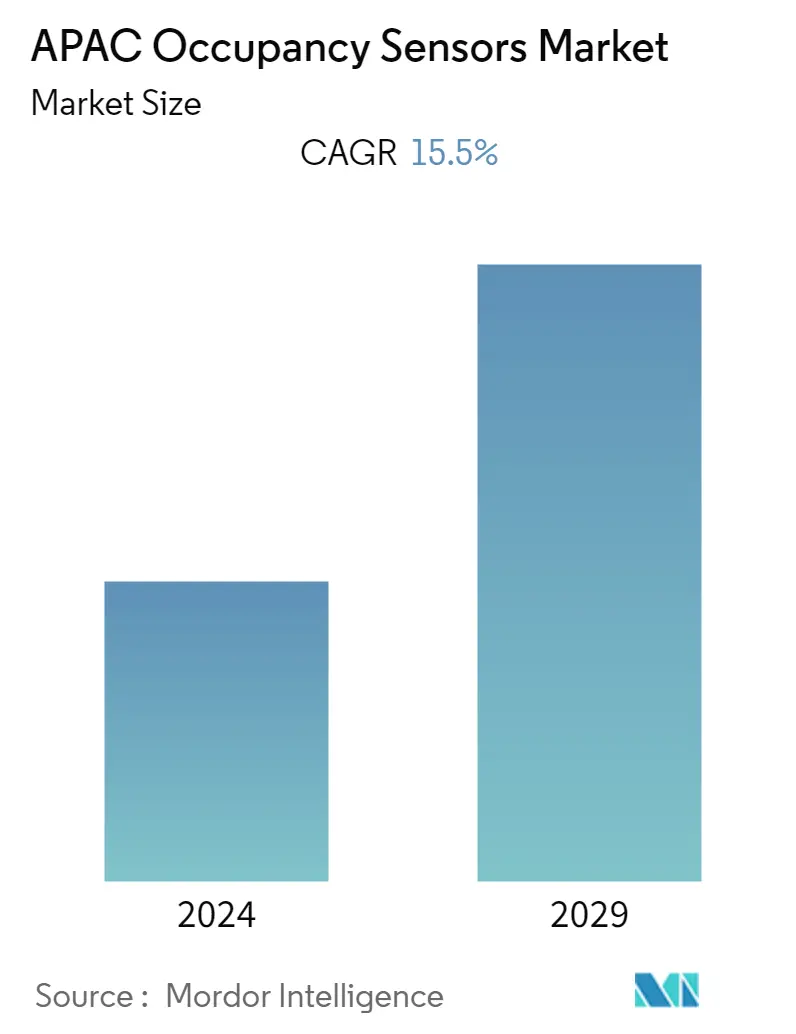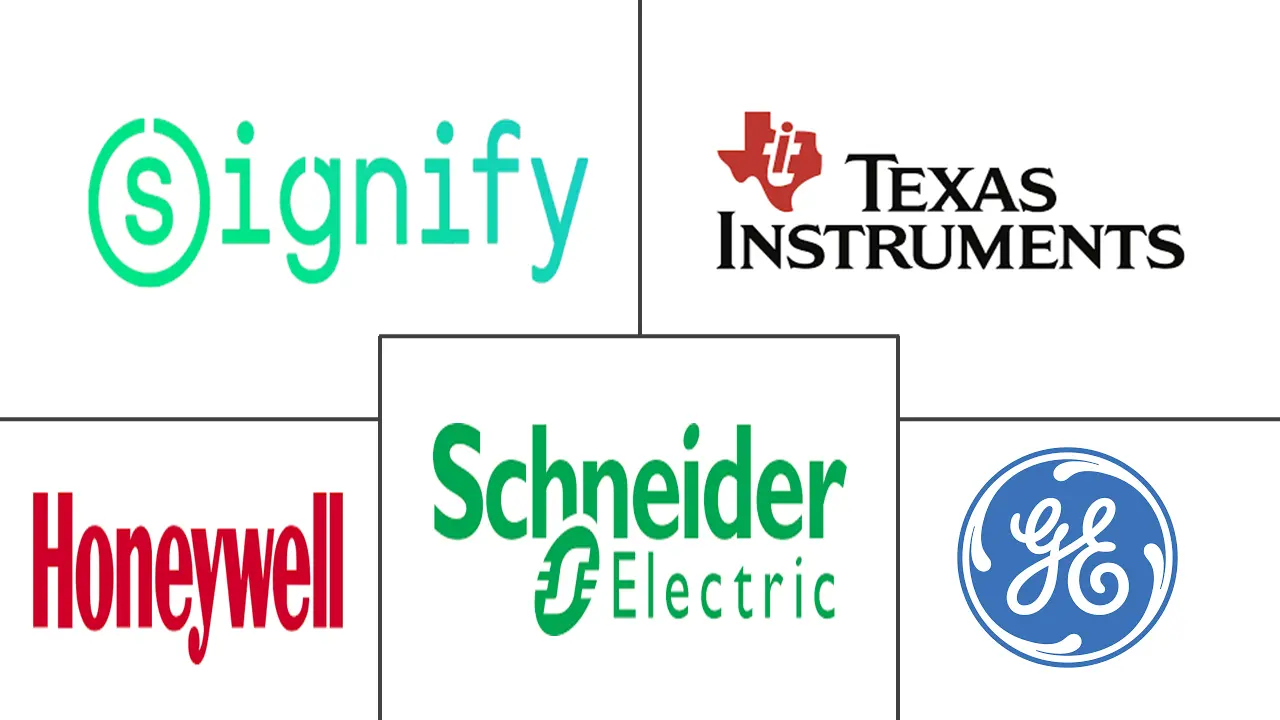Market Size of APAC Occupancy Sensors Industry

| Study Period | 2019 - 2029 |
| Base Year For Estimation | 2023 |
| Forecast Data Period | 2024 - 2029 |
| Historical Data Period | 2019 - 2022 |
| CAGR | 15.50 % |
| Market Concentration | Medium |
Major Players
*Disclaimer: Major Players sorted in no particular order |
APAC Occupancy Sensor Market Analysis
The Asia Pacific Occupancy Sensors Market is expected to register a CAGR of 15.5% during the forecast period, 2021-2026. Smart building technology and occupancy sensors can provide real-time data, allowing to make better decisions for building management under the new guidelines of COVID-19. Whether saving space or improving hygiene, occupancy IoT sensors can help mobilize and optimize the back-to-work process.
- Occupancy sensors indicate the presence or absence of occupants in a space using various technologies such as passive infrared, ultrasonic, and dual-technology. Passive-infrared sensors necessitate a line of sight between the sensor and the space's occupants.
- Further, to reduce energy waste, most energy codes require some method of automatically turning off lights when they are not in use, either on a schedule or based on occupancy. Occupancy sensors are lighting controls that turn off lights in unoccupied areas, lowering energy costs by reducing energy waste. Also, various vendors in the region are introducing Ultrasonic sensors to detect the presence of people by emitting ultrasonic sound waves into the environment and measuring the speed with which they return.
- Also, there is an increasing focus on Dual-technology sensors that use both passive infrared and ultrasonic technologies to detect the presence of occupants and activate the lights only when both technologies detect the presence of occupants. This configuration virtually eliminates the possibility of false-on problems, and requiring either technology to keep the lights on significantly reduces the possibility of false-off problems.
- Private companies are partnering with vendors to become energy efficient. For instance, Larsen & Toubro Infotech (LTI) partnered with 75F to eliminate challenges related to inefficient lighting. 75 installed its Advanced Lighting Solution to improve occupant experience. As a result, LTI achieved an energy saving of 55%.
APAC Occupancy Sensor Industry Segmentation
An occupancy sensor is used to save energy, comply with building codes, and provide automatic control and various other such applications. One of the most-used technologies among the occupancy sensors is the passive infrared, which detects occupancy within a specific field and activates lighting, and is extremely useful in small spaces. Moreover, the advent of advanced occupancy sensors, such as micro-phonics, intelligent occupancy sensors, image processing occupancy sensors, and the new vision-based intelligent occupancy sensor, for HVAC systems is fueling the growth of the occupancy sensor market.
| By Network Type | |
| Wired | |
| Wireless |
| By Technology | |
| Ultrasonic | |
| Passive Infrared | |
| Microwave |
| By Application | |
| Lighting Control | |
| HVAC | |
| Security and Surveillance |
| By Building Type | |
| Residential | |
| Commercial |
| By Country | |
| China | |
| Japan | |
| India | |
| Rest of Asia Pacific |
APAC Occupancy Sensors Market Size Summary
The Asia Pacific Occupancy Sensors Market is experiencing significant growth, driven by the increasing adoption of smart building technologies and the need for energy-efficient solutions. Occupancy sensors, which utilize technologies such as passive infrared, ultrasonic, and dual-technology, play a crucial role in optimizing space management and reducing energy consumption. These sensors are integral to modern building management systems, providing real-time data that aids in decision-making and enhances operational efficiency. The market is characterized by a shift from traditional lighting control systems to smart, wireless, and touchless solutions, which are gaining traction in both residential and commercial sectors. This transition is supported by innovations such as photoelectric infrared sensors and smart thermostats, which contribute to energy savings and improved user experiences.
The competitive landscape of the Asia Pacific Occupancy Sensors Market is marked by strategic initiatives such as product launches, partnerships, and acquisitions, as companies strive to maintain their market positions. Key players are focusing on research and development to introduce advanced sensor technologies that cater to diverse applications, including security, access control, and energy management. The market is also witnessing collaborations aimed at enhancing product offerings and expanding market reach. Notable developments include the introduction of IoT sensor packages and AI-driven sensing solutions, which are setting new standards in occupancy detection and building automation. As the demand for energy-efficient and smart solutions continues to rise, the market is poised for further expansion, with companies leveraging technological advancements to meet evolving consumer needs.
APAC Occupancy Sensors Market Size - Table of Contents
-
1. MARKET INSIGHTS
-
1.1 Market Overview
-
1.2 Industry Attractiveness - Porter's Five Forces Analysis
-
1.2.1 Bargaining Power of Suppliers
-
1.2.2 Bargaining Power of Consumers
-
1.2.3 Threat of New Entrants
-
1.2.4 Threat of Substitutes
-
1.2.5 Intensity of Competitive Rivalry
-
-
1.3 Assessment of the Impact of COVID-19 on the Market
-
-
2. MARKET SEGMENTATION
-
2.1 By Network Type
-
2.1.1 Wired
-
2.1.2 Wireless
-
-
2.2 By Technology
-
2.2.1 Ultrasonic
-
2.2.2 Passive Infrared
-
2.2.3 Microwave
-
-
2.3 By Application
-
2.3.1 Lighting Control
-
2.3.2 HVAC
-
2.3.3 Security and Surveillance
-
-
2.4 By Building Type
-
2.4.1 Residential
-
2.4.2 Commercial
-
-
2.5 By Country
-
2.5.1 China
-
2.5.2 Japan
-
2.5.3 India
-
2.5.4 Rest of Asia Pacific
-
-
APAC Occupancy Sensors Market Size FAQs
What is the current APAC Occupancy Sensors Market size?
The APAC Occupancy Sensors Market is projected to register a CAGR of 15.5% during the forecast period (2024-2029)
Who are the key players in APAC Occupancy Sensors Market?
Signify Holding BV, Texas Instruments Inc, Schneider Electric SE, Honeywell Inc and General Electric Co are the major companies operating in the APAC Occupancy Sensors Market.

